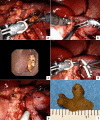Robot-assisted laparoscopic surgery for treatment of urinary tract stones in children: report of a multicenter international experience
- PMID: 33993337
- PMCID: PMC8560673
- DOI: 10.1007/s00240-021-01271-5
Robot-assisted laparoscopic surgery for treatment of urinary tract stones in children: report of a multicenter international experience
Abstract
This study aimed to report a multi-institutional experience with robot-assisted laparoscopic surgery (RALS) for treatment of urinary tract stones in children. The medical records of 15 patients (12 boys), who underwent RALS for urolithiasis in 4 international centers of pediatric urology over a 5-year period, were retrospectively collected. The median patient age was 8.5 years (range 4-15). Eleven/fifteen patients (73.3%) had concurrent uretero-pelvic junction obstruction (UPJO) and 2/15 patients (13.3%) had neurogenic bladder. Stones were in the renal pelvis in 8/15 (53.3%), in the lower pole in 3/15 (20%), in the bladder in 2/15 (13.3%), and in multiple locations in 2/15 (13.3%). One patient (6.6%) had bilateral multiple kidney stones. The median stone size was 10.8 mm (range 2-30) in upper tract location and 27 mm (range 21-33) into the bladder. Eleven patients with concomitant UPJO underwent simultaneous robot-assisted pyelolithotomy and pyeloplasty in 12 kidney units. Two patients with isolated staghorn stones received robot-assisted pyelolithotomy. Robot-assisted cystolithotomy was performed in two patients with bladder stones. The median operative time was 131.8 min (range 60-240). The stone-free rate was 80% following initial surgery and 100% after secondary treatment. Clavien 2 complications (hematuria, infections) were recorded in 5/15 patients (33.3%). Three/fifteen patients (20%) with residual renal stones were successfully treated using ureterorenoscopy (Clavien 3b). RALS was a feasible, safe and effective treatment option for pediatric urolithiasis in selected cases such as large bladder stones, bilateral kidney stones, staghorn stones or concomitant anomalies such as UPJO requiring simultaneous pyeloplasty.
Keywords: Children; Lithotomy; Nephroscopy; Pyeloplasty; Robot; Stones.
© 2021. The Author(s).
Conflict of interest statement
The authors declare that they have no conflict of interest.
Figures




Similar articles
-
Ureteropelvic junction obstruction and renal calculi: Simultaneous treatment by robot-assisted laparoscopic pyeloplasty and transcutaneous retrograde flexible ureteroscopy. Technique description and early outcomes.Prog Urol. 2023 Apr;33(5):279-284. doi: 10.1016/j.purol.2023.01.006. Epub 2023 Feb 13. Prog Urol. 2023. PMID: 36792487
-
Combined treatment of ureteropelvic junction obstruction and renal calculi with robot-assisted laparoscopic pyeloplasty and laser lithotripsy in children: Case report and non-systematic review of the literature.Int J Med Robot. 2021 Jun;17(3):e2246. doi: 10.1002/rcs.2246. Epub 2021 Mar 7. Int J Med Robot. 2021. PMID: 33626232 Review.
-
Treatment of ureteropelvic junction obstruction in patients with renal calculi via laparoscopic pyeloplasty and flexible vacuum-assisted ureteral access sheath ureteroscopy: a multicenter retrospective observational study.BMC Urol. 2024 Mar 26;24(1):70. doi: 10.1186/s12894-024-01453-4. BMC Urol. 2024. PMID: 38532342 Free PMC article.
-
Endoscopic-assisted robotic pyelolithotomy: a viable treatment option for complex pediatric nephrolithiasis.J Pediatr Urol. 2020 Apr;16(2):192.e1-192.e5. doi: 10.1016/j.jpurol.2019.12.007. Epub 2019 Dec 19. J Pediatr Urol. 2020. PMID: 31932240
-
Ureteropelvic obstruction and renal stones: etiology and treatment.Urolithiasis. 2015 Feb;43(1):5-12. doi: 10.1007/s00240-014-0736-2. Epub 2014 Nov 2. Urolithiasis. 2015. PMID: 25362543 Review.
Cited by
-
Primary hyperoxaluria type 1: urologic and therapeutic management.Clin Kidney J. 2022 May 17;15(Suppl 1):i14-i16. doi: 10.1093/ckj/sfab187. eCollection 2022 May. Clin Kidney J. 2022. PMID: 35592623 Free PMC article. Review.
-
Navigating the Evolving Landscape of Primary Hyperoxaluria: Traditional Management Defied by the Rise of Novel Molecular Drugs.Biomolecules. 2024 Apr 23;14(5):511. doi: 10.3390/biom14050511. Biomolecules. 2024. PMID: 38785918 Free PMC article. Review.
-
International Alliance of Urolithiasis (IAU) guidelines on the management of pediatric urolithiasis.Urolithiasis. 2024 Sep 4;52(1):124. doi: 10.1007/s00240-024-01621-z. Urolithiasis. 2024. PMID: 39230669
-
A combined approach of robot-assisted laparoscopic pyeloplasty and flexible endoscopy to treat concomitant ureteropelvic junction obstruction and calyceal stones in children: Technical considerations and review of the literature.Front Pediatr. 2022 Oct 28;10:1017722. doi: 10.3389/fped.2022.1017722. eCollection 2022. Front Pediatr. 2022. PMID: 36389392 Free PMC article.
-
Pediatric robotic urologic procedures: Indications and outcomes.Indian J Urol. 2023 Apr-Jun;39(2):107-120. doi: 10.4103/iju.iju_276_22. Epub 2023 Mar 31. Indian J Urol. 2023. PMID: 37304986 Free PMC article. Review.
References
Publication types
MeSH terms
LinkOut - more resources
Full Text Sources
Other Literature Sources

